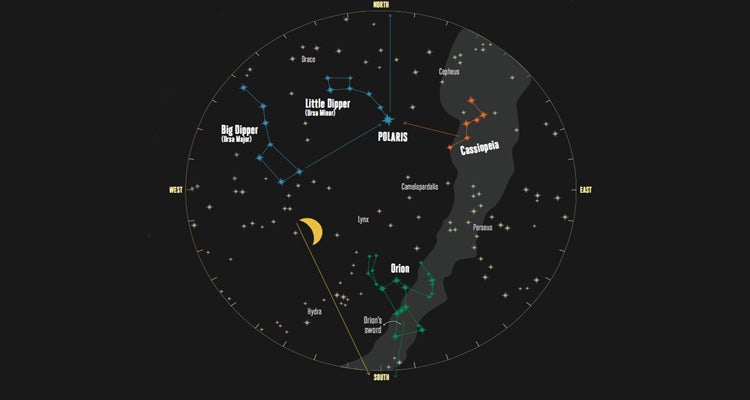How to Navigate by the Stars

'Illustration by Giovanni Corrado Leone'
Star navigation is an easy way to stay on the right path in low (or no) light. Using the stars as a map is how our ancient ancestors found their way; you can do it too. Here’s how.
Find North
First, find Polaris, or the North Star, which lies almost directly above the north celestial pole. You’ll locate Polaris straight out from the tip of the Big Dipper’s bowl, almost as if it were being poured from the giant ladle. If you hit Cassiopeia—which is shaped like a “W”—you’ve gone too far.
If the Big Dipper isn’t visible (it could be obscured by clouds, or terrain when it’s low on the horizon), you can still find Polaris by following a line bisecting the wider “V” of Cassiopeia. Polaris is also the end of the handle on the Little Dipper. Once you find it, let your eyes fall to the point on the horizon directly below. This will be close to due north.
Tip: Polaris should be the number of degrees of your current latitude above the horizon.
Find South
If the moon is a crescent and high in the sky, connect the tips of the crescent. Find where the line hits the horizon—that’s south. If Orion is high in the sky and his sword is close to vertical, the point where the line made by the sword would hit the horizon also points you south. (Note: Both of these methods yield rough estimates compared to finding north with Polaris, which is highly accurate.)
Save your Direction
If you’re using one of these methods to orient yourself but will wait for daylight to hike, draw an arrow in the dirt (or use rocks or sticks) so you don’t go astray come morning.
Tell Time Through Star Navigation
Imagine a giant clock in the sky, with the line you drew connecting Polaris and the Big Dipper as the hour hand. This clock is a little different than your average analog—it’s a 24-hour clock and it runs counterclockwise. On March 6, it’s perfectly accurate. In any other month, take the number of months after March 6, multiply it by two, and subtract it from the time you read (don’t forget to add an hour during daylight savings time). If the Big Dipper isn’t visible, you can use Cassiopeia. The line that connects the tip of the narrow “V” and Polaris is your new hour hand, and the date to remember is March 21.
*These star navigation tips only work for orienting yourself when you’re traveling in the Northern Hemisphere.